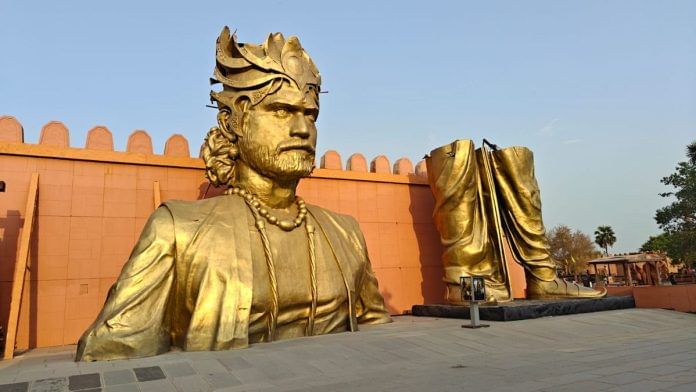Hyderabad: In Hyderabad’s Ramoji Film City, the crew is racing against the clock to finish the set of Fauji, a period saga set in the 1970s. They are building a retro prison with rows of cells, each equipped with mugs, plates, and frayed blankets. An old notice board indicates the number of prisoners in each cell. The corridor is dimly lit, creating an atmosphere of foreboding.
The set of Hanu Raghavpudi’s pan-India film, starring Jaya Prada and Anupam Kher, is the latest created by the studio’s artisans this hot Hyderabad afternoon. The city’s skyline is dotted with massive film studios. It isn’t an addendum to the Telugu film industry. The studios are an economy unto themselves.
Hyderabad may be best known for the Charminar and its biryani, but the city has a newer claim to fame. With Telugu movies becoming globally recognised for their elaborate production design and cutting-edge technology, Hyderabad is now the city of studios.
“Be it Sarathi, Ramoji, or Annapurna, the studios are constantly evolving, compared to many other filmmaking industries. Everyone wants to do something new—get new tech, and be good service providers above everything else,” said director Shouryuv, who shot portions of his film Hi Nanna (2023) at Ramoji Film City.
There is never a lack of space or one set needing to be dismantled to build another, if a filmmaker wants to keep the set
-Poornachandra Rao, Ramoji’s manager of floors
Set up by filmmakers and producers like Akkineni Nageswara Rao, Yarlagadda Sivarama Prasad, and Ramoji Rao, Hyderabad’s top seven studios have not just weathered political upheavals and churns in the entertainment industry. They are thriving. In 2022, Pushpa star Allu Arjun launched Allu Studios, a sprawling 10-acre facility with state-of-the-art technology. Producer Cherukuri Ramoji Rao’s Ramoji Film City spans more than 2,000 acres and is touted as the world’s largest film studio. Annapurna, one of the most high-tech studios in the country, was set up in 1975 by Akkineni Nageswara Rao (ANR). Smaller recording studios have also come up, bringing the total to 25. And now, another studio is slowly taking form at the Aluminium Factory in Gachibowli, where RRR (2022) was shot. Director SS Rajamouli has leased part of the 100-acre abandoned factory for his upcoming Mahesh Babu-starrer, with set construction beginning last year.
Today, these studios are attracting big names from Chennai and Mumbai. Parts of Kamal Haasan’s Tamil hit Amaran (2024) and Shah Rukh Khan’s Jawan (2023) were filmed in Hyderabad. Even the Maldives sequence of Pushpa 2: The Rule was created in landlocked Hyderabad.
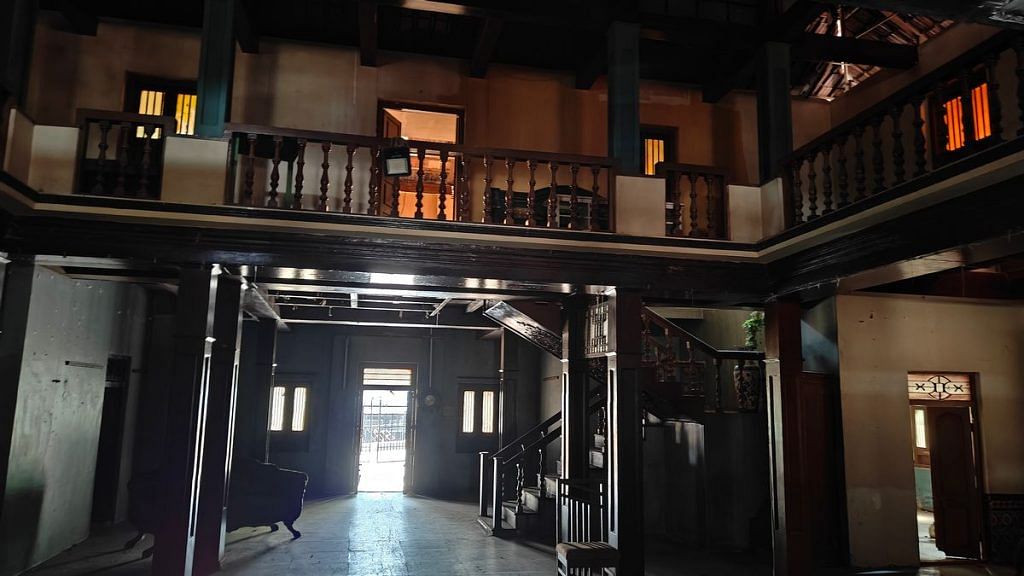
While the future of Indian cinema seems to lie in Hyderabad’s studios, even neighbouring Andhra Pradesh wants a piece of the action. In 2024, Deputy Chief Minister Pawan Kalyan, also a popular film star, urged Tollywood filmmakers to shift operations to Andhra Pradesh. But as of now, there’s no place quite like Telangana’s city of studios.
In Chennai and Mumbai, longstanding institutions like Gemini Studios, RK Studios, and Kamal Amrohi’s Kamalistan have downed their shutters. But in Hyderabad, studios are diversifying. They’re offering not just rental space and top-notch post-production facilities but also positioning themselves as one-stop shops for filmmakers.
Geography, ambition, and investment have all had a role to play.
“Hyderabad is closer to Mumbai than Chennai, so it also helps Hindi movie makers to come here and shoot. This is how we became a strong ecosystem,” said D Suresh Babu, head of Ramanaidu Studios and Suresh Productions. “We grew because we also welcomed other industries to make their films here.”
Also Read: Hyderabad’s Annapurna Studios is India’s high-tech film hub. A 50-yr Nagarjuna family legacy
Wonderland for filmmakers and movie buffs
No visit to Hyderabad is complete without a stop at Ramoji Film City. With movie sets from blockbusters like Baahubali, Pushpa 2 and now, Fauji, it’s India’s answer to Universal Studios. Amusement parks, guided set tours, themed gardens, and cultural activities are all part of its grand world.
There’s even a realistic railway station, complete with an engine, two coaches, and waiting rooms, where visitors can pose like Shah Rukh Khan and Kajol in the “Ja Simran” train scene from Dilwale Dulhania Le Jayenge.

The studio was a pop culture moment when it opened, rivalling Hollywood in terms of sheer size. It even held a Guinness record for being the world’s largest film studio complex. But Ramoji is no relic of a bygone era.
“I love watching movies, and now my kids are equally enthusiastic. We all wanted to see the sets of Baahubali, and we finally did,” said Lata Kumari, who was on a family trip and had opted for a day-long tour at the studio. She got to experience the Mahishmati kingdom created by Rajamouli in his movies. People stared wide-eyed at the space where Devdesena was tortured. Others queued up to click Instagram and WhatsApp profile pictures on Bhalladeva’s throne.
“We built the entire set of Baahubali in about three months. It took almost five years for the filming of both movies,” said Peddi Raju, an executive in the location department.
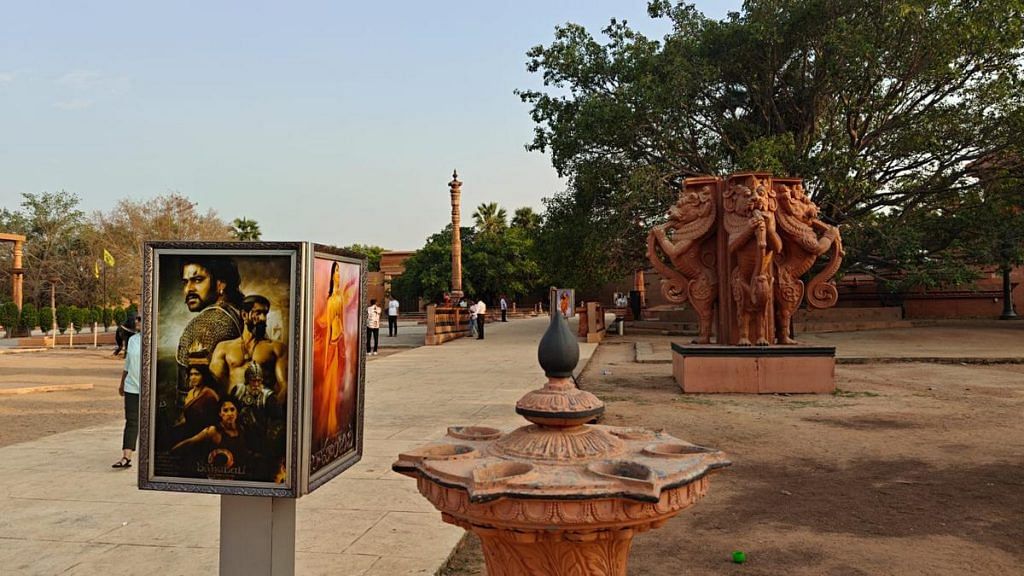
The studio also has a restaurants that pays tribute to the Baahubali universe. The Baahubali Darbar serves cocktails and biryani named after film characters, such as Avantika Lemonade, Devasena Biryani, and Kalakeya Lemonade. The studio is also a coveted wedding destination, thanks to its Mughal garden sets and faux palaces.
Filmmakers across India keep Ramoji’s manager of floors, Poornachandra Rao, and art director Srinivas Rao on speed dial.
“Rohit Shetty always comes here to shoot his films,” said Rao beaming with pride. The filmmaker is a Bollywood hit-spinner, with films like Golmaal, Singham and Chennai Express under his belt.

In the Hindi film industry, Mumbai’s studio culture has faded. Filmmakers now seek unexplored regions like Bihar’s Daltonganj, or even Sikkim, where the upcoming Aashiqui 3, starring Telugu actor Sreeleela and Kartik Aaryan, was shot. But Telugu filmmakers know that they can get lifelike sets in Hyderabad.
“Shooting in studios helps cut down costs. Actors can also drive in from their homes. We can finish shooting much faster,” said producer Sudheer Edara.
From streets resembling London to villages modelled on South India’s coasts, the shooting options at Ramoji Film City are staggering.
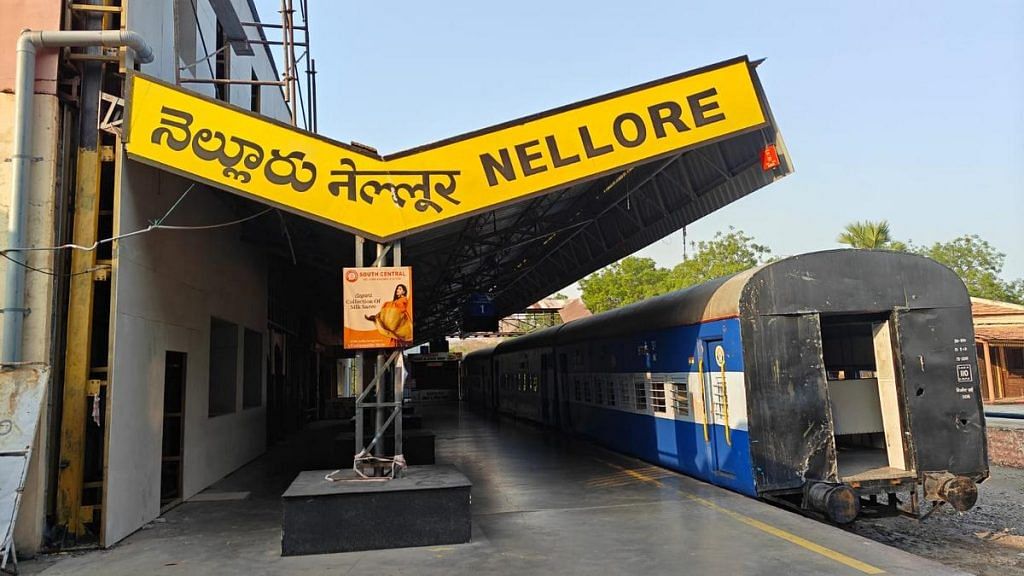
Cocktail (2012), set in London, shot many scenes here, including those where Veronica (Deepika Padukone), Meera (Diana Penty), and Gautam (Saif Ali Khan) walk around and regroup for their lunch breaks. The song Titli from Chennai Express (2013), where romance blossoms between Meenamma (Deepika Padukone) and Rahul (Shah Rukh Khan), was filmed on a village set here. The lavish set of Ooh La La from The Dirty Picture was also a Ramoji creation.
The magic unfolds at Maya, the department that brings these film sets to life. From an idol of a god to a village, a dhaba, or a swanky European restaurant, it’s the studio’s wish-fulfilment team. No creative vision is out of reach for the art department.
While shooting a dramatic scene for Hi Nanna, Shouryuv realised he needed equipment that is no longer common in filmmaking. He wanted a long camera crane, which can move smoothly and steadily from a 10-storey-high building to the ground, or hover in place without the use of tracks.
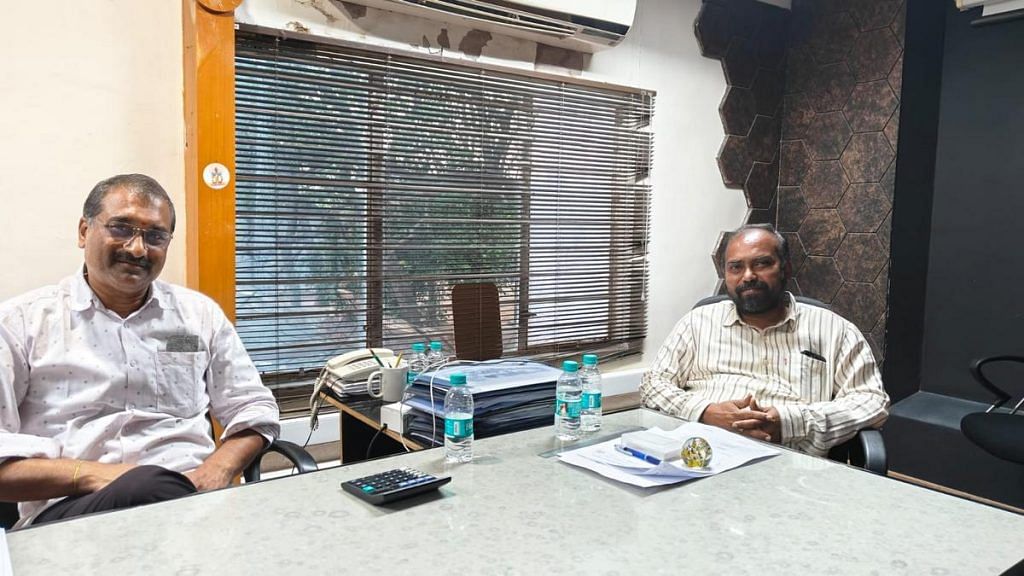
“It is called a strada, and I was worried how I’d get it. But Ramoji had it, and also the crew to handle it. It is probably the only one in Hyderabad,” said Shouryuv.
With the five-star hotel Sitara, the three-star Tara, in-house organic farms where peacocks call from mango orchards, and every kind of filming equipment imaginable, Ramoji Film City is like a filmmaker’s fantasy.
But it faces stiff competition in Hyderabad. Across the city, other studios have carved out their own niches, catering to different budgets, genres, and filmmaking needs.
How Hyderabad became a filming hotspot
Jubilee Hills is the filmmaking pincode of Hyderabad. The area houses some of the city’s oldest studios—Ramanaidu, Annapurna, Ramakrishna, Padmalaya, and Sabdhalaya Theatres—as well as production houses like Vyjayanthi Movies. Even the Hyderabad International Convention Centre, home to the Filmfare Awards South ceremony, is located in the vicinity. Telugu heavyweights like Arjun, Nagarjuna, Junior NTR, Chiranjeevi, Daggubati Venkatesh, and SS Rajamouli all have palatial residences here as well.
But it took decades for Hyderabad to become the beating heart of the Telugu film industry. In the 1970s, Chennai was still the hub. The change began when ANR returned to Andhra Pradesh and established Annapurna Studios in 1975. Barring a few exceptions, he subsequently only worked on films produced in the state.
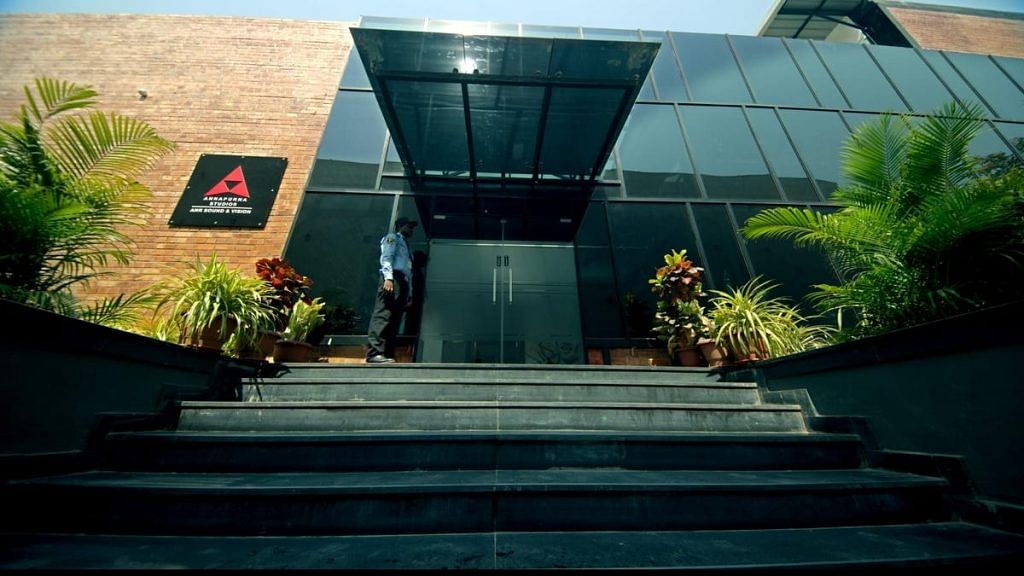
The move away from Chennai got a boost when actor N T Rama Rao or NTR became Andhra Pradesh chief minister in 1983, followed by Marri Chenna Reddy. Their governments offered subsidies for films produced in the city, loans for building industry infrastructure, and the Nandi Awards for Telugu films. These incentives persuaded other filmmakers and producers to shift base. Filmmaker and Padma Bhushan awardee Daggubati Ramanaidu relocated from Chennai in 1983 and set up Ramanaidu Studios in Jubilee Hills a few years later.
The cultural shift did not happen overnight. The film industry moved in fits and starts, still holding on to Chennai. But the opening of Ramoji Film City in 1996 cemented Hyderabad’s moviemaking rise.
Most Telugu studio owners were also producers, creating an ecosystem that continues to thrive. Workers settled in Krishnanagar, formed unions, and built a robust industry, having learned from their experiences in Chennai.
We have always tried to find ways to push the industry ahead and set best practices. Both Annapurna and we set up our film schools here so the industry could have trained and skilled technicians. Many of our students have ended up working on major projects
-D Suresh Babu, head of Ramanaidu Studios
Today, each studio is a kingdom in itself. And their reach extends to other states in south India. Many big Tamil stars, from Rajinikanth to Vijay, have chosen the city’s studios to shoot films like Enthiran (2010) and Varisu (2023).
Recently, Mohanlal’s Malayalam blockbuster L2: Empuraan and the Tamil film Amaran opted for post-production at Annapurna. Ajith Kumar’s heist thriller Thunivu was filmed entirely at Ramoji Film City.
The Telugu industry may fiercely compete with other Indian film industries, be it Tamil or Hindi, but within its ecosystem, collaboration is key.
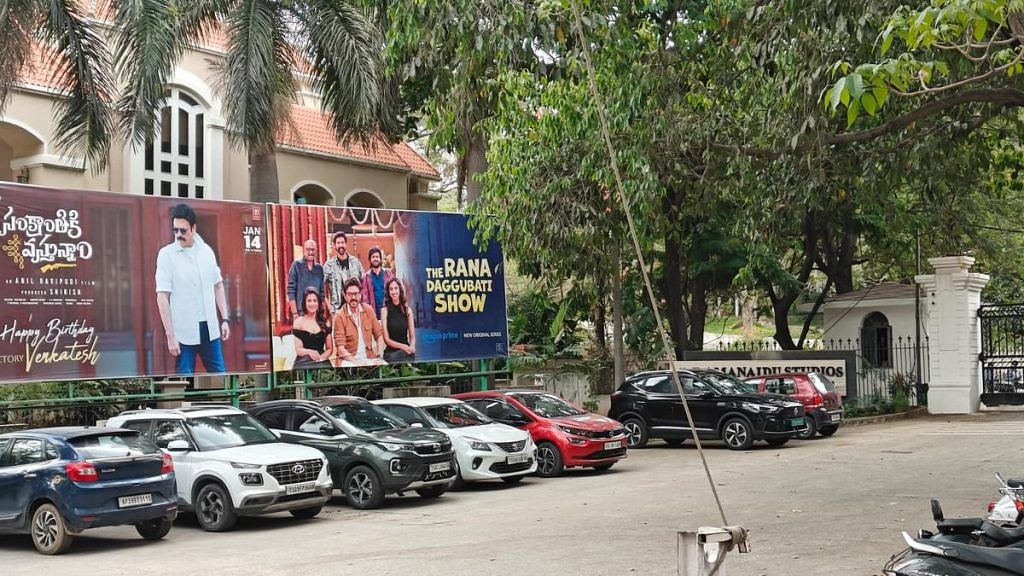
If studios are integral to Telugu cinema’s growth, so is harmony among owners, who are usually directors, producers, distributors, and actors themselves.
“We look out for each other, and try to make space for as many films to do well as possible, especially with Sankranthi being a big audience puller,” said Ramanaidu’s son, Suresh Babu, managing director of Suresh Productions.
Even in the early days, the studios worked together to upgrade the industry. Annapurna created self-contained studio floors and virtual stages; Ramanaidu brought in advanced sound systems; LV Prasad brought in colour grading technology at Prasad Studios. Hyderabad’s proximity to Mumbai and the bouquet of expansive studios also helped attract Hindi filmmakers. Popular Hindi hits like Tezaab (1988), Coolie No. 1 (1995), and Dulhe Raja (1998) were shot in Hyderabad’s studios.
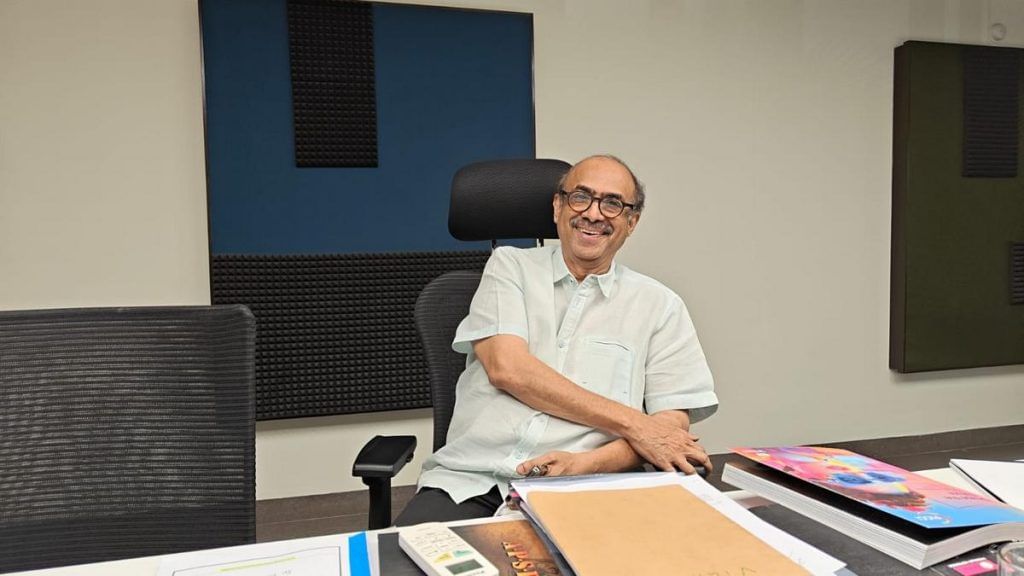
The studios didn’t stop at building filming infrastructure. Ramanaidu and Annapurna both opened film schools on their premises to train the next generation of filmmakers and technicians.
“We have always tried to find ways to push the industry ahead and set best practices. Both Annapurna and we set up our film schools here so the industry could have trained and skilled technicians. Many of our students have ended up working on major projects,” said Babu.
Fortresses, franchises, fanfare
Star culture may be on the decline in Bollywood, but in Telugu cinema, superstars still reign supreme. From Chiranjeevi and Nagarjuna to Mahesh Babu, Nani, and Allu Arjun, fans line up all night to catch the ‘first day first show’ of their idols.
The Telugu film industry has the largest number of actively working male stars, ranging in age from their 20s to their 60s. Well-fortified studio spaces are especially essential here so that shoots can take place without fans overrunning the sets.
Studios also help sustain the star culture by shielding actors and maintaining the larger-than-life aura that stardom depends on.
The studios… give a chance to everyone to have a unique vision and make it happen, inside the city
-Shouryuv, director
“Look at the stampede that happened at Sandhya theatre. That is the level of craze for the stars here. It is understandable why stars prefer the privacy and ease of shooting in studios,” said a film director. In December 2024, a stampede broke out when Allu Arjun made a surprise visit to Sandhya Theatre during a special show of Pushpa 2. Fans started pushing each other, trying to get a glimpse of their star, leading to the death of a woman.
But it’s not just the stars who are larger-than-life. So are the worlds their movies need—and the studios make them possible. Directors like Nag Ashwin can dream up films such as the star-studded Kalki 2898 AD, where the futuristic cities of Kasi and Sambhala were brought to life at Ramoji Film City.
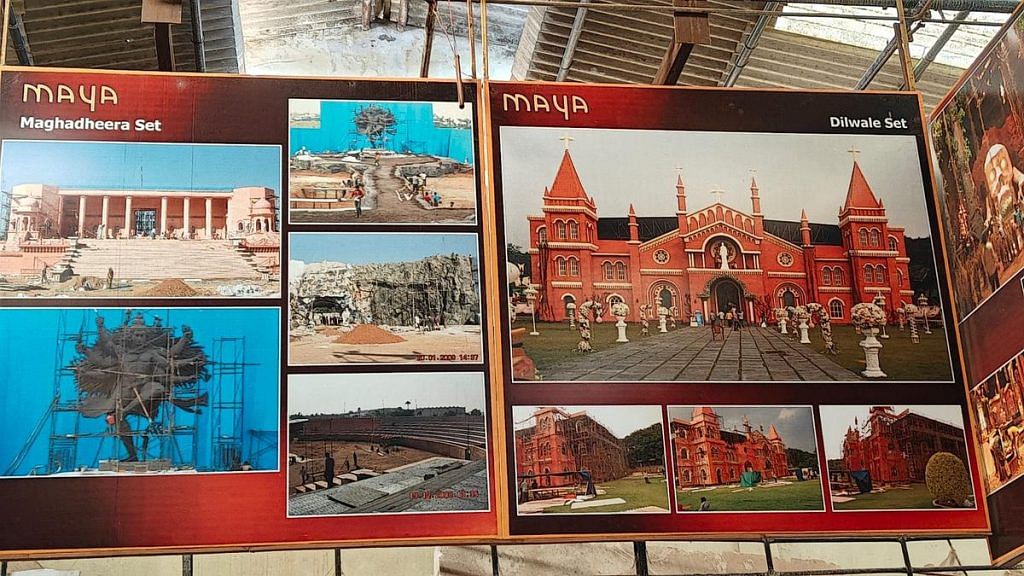
But the appeal of studio shooting is not just restricted to filmmakers with big budgets. The 2024 surprise hit Hanu-Man, starring Tejja Sajja, was made on a budget of Rs 40 crore, and was mostly shot in studios. It went on to make nearly Rs 300 crore. The studios and movies have a symbiotic relationship. Sets for franchise films are maintained so directors can return for sequels. It’s a way for franchises like Pushpa and Salaar to ensure continuity on sets.
“There is never a lack of space or one set needing to be dismantled to build another, if a filmmaker wants to keep the set,” said Poornachandra Rao.
But political storms and the tug-of-war between Andhra Pradesh and Telangana are threatening to upset the apple cart.
Also Read: How big stars and bloated blockbusters are bleeding Bollywood dry
Can Vizag steal the show?
Film personalities in Hyderabad have always rubbed shoulders with the Telugu region’s political supremos, and have even been part of the political culture. But recent events have created rifts between the two powerful sections. The Andhra-Telangana divide of 2014 has also affected the Telugu film industry.
Tensions started brewing in 2021 when then Andhra chief minister YS Jagan Mohan Reddy issued an order to fix price slabs for movie theatres. In municipal corporation areas, the ticket price at multiplexes was capped at Rs 75–200. The film industry, including theatre owners, were up in arms against the decision, saying it threatened to subvert movie-going culture. Tickets can go for as much as Rs 2,000 whenever a big star’s film is released. For the May release of the action thriller HIT 3, the Andhra government officially approved a temporary hike in ticket price, allowing multiplexes to raise the price by Rs 75, including GST.
At the same time, there’s been a push for the film industry to shift to Visakhapatnam, or Vizag, in Andhra Pradesh. Jagan even promised land for studios and residences for stars.
It was a déjà vu moment. The Telugu industry had once moved from Chennai to Hyderabad. But things are different now. Industry giants have made Jubilee hills their residence and workplace.
What may happen is expansion of the industry, not a complete relocation
-Vamshi Krishna Reddy, film studies professor
When actor Pawan Kalyan became Andhra Pradesh’s deputy chief minister in 2024, he revived the call to shift filmmaking to Visakhapatnam. Earlier, his brother Chiranjeevi had declared he wanted to settle in the coastal city, sharing that he’d bought a property worth Rs 30 crore there.
“Kalyan’s ambition is to grow politically. Development politics is key to south India—when industries are brought in, it is welcomed. And filmmaking is one of the biggest industries that would help Visakhapatnam,” said Vamshi Krishna Reddy, a film studies professor at the University of Hyderabad. “He would also get the credit of finally starting the process that did not work in KCR’s reign.”

K Chandrashekar Rao, or KCR, the face of the Telangana movement, had reportedly said that he would bulldoze Ramoji Film City if he was voted to power (although he has since denied making that statement). But after becoming Telangana’s first CM, he instead helped the industry and its studios flourish.
Now, even as rhetoric about Visakhapatnam as the next big filming hub grows—with much made of its natural beauty, beaches, temples, and cosmopolitan population—there are cracks in this grand ambition.
The Telugu film industry runs on Hyderabad time. The studios are well established. The stars have built luxurious homes in the city. There are no corresponding homes or even resorts in Visakhapatnam, either for the stars or the crew. So, a second homecoming to Visakhapatnam, almost 50 years after the move from Chennai to Hyderabad, is unlikely to materialise. The only Hyderabad studio that has a branch in Visakhapatnam is Ramanaidu.
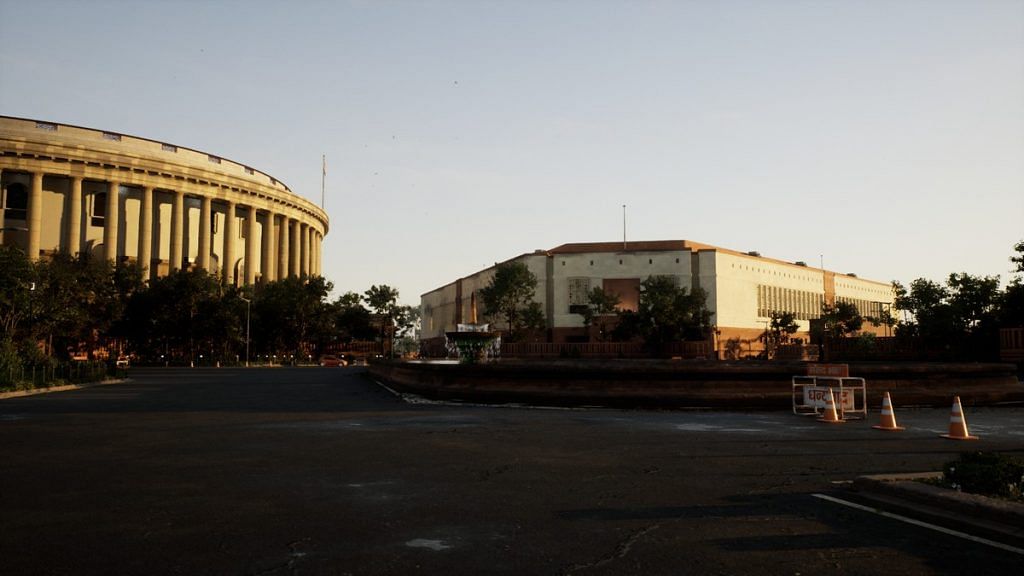
Even many Andhra-based officials and professionals prefer spending weekends in Hyderabad, which is regularly ranked among India’s most liveable cities.
From Dolby Atmos-certified sound stages and a Virtual Production Stage at Annapurna Studios, to 24/7 VFX at Ramanaidu, to the creative world-building at Ramoji, Hyderabad is decades ahead of its proposed rival. Green Gold Animation, the company behind the popular cartoon Chhota Bheem, is even bringing in motion capture to create live-action films in the future.
“What may happen is expansion of the industry, not a complete relocation,” said Vamshi Krishna Reddy.
For now, the studios are focused on expanding their reach across India. They want Hyderabad to be crowned as the country’s filmmaking capital. Director Prashanth Neel, known for Salaar: Part 1 – Ceasefire (2023), is currently shooting at Ramoji Film City with Jr NTR and over 2,000 junior artistes for his next big venture.
“You do not get a Baahubali every year, but there is a possibility that you get it every two years. You can have a smaller budget film like Hanu-Man making money,” said Shouryuv. “That is what the studios do—give a chance to everyone to have a unique vision and make it happen, inside the city.”
(Edited by Asavari Singh)



